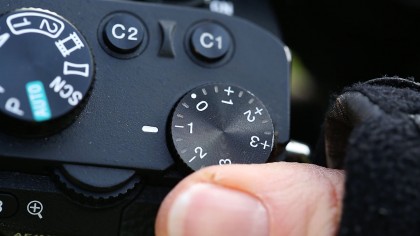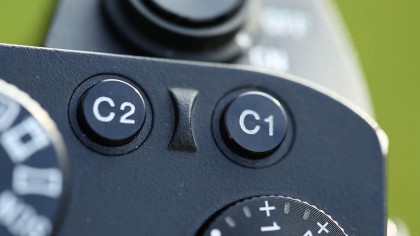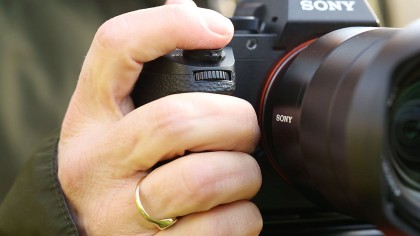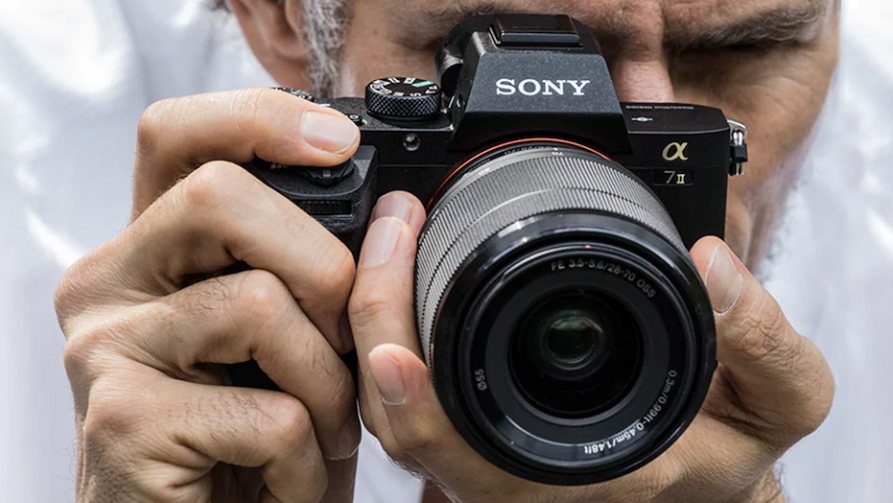Why you can trust TechRadar
Build and handling
- Feels nice and solid in the hand
- Moisture and dust sealed
- Excellent electronic viewfinder
Like the other cameras in the Alpha 7-series, the A7 II has rather angular, old school appearance which many photographers will find appealing. It also feels nice and solid in the hand. According to Sony the sensor housing has been made stronger in the A7 II with more magnesium alloy than in the original camera. This, combined with the camera's moisture and dust sealing, should make the camera pretty durable.
Sony has given the A7 II a deeper, more comfortable grip than the A7 and there's a new richly textured coating that gives excellent purchase. On the back of the camera there's also a small but effective thumb-ridge, which has the same coating as the front grip. These elements combine to make the camera feel very comfortable and more secure in the hand than the A7 when shooting or walking between shots.
Other changes made since the A7 include a slightly larger shutter button which has been moved forward to make it easier to reach.We found this to be a good move as the button falls under the point that we automatically reach to when holding the A7 II.
Just below the shutter release, at the top of the grip, is a small protruding dial that's used for exposure adjustments. This replaces the large dial found near the shutter release on the A7. While the new dial is a little fiddly to find when you've got cold fingers, this is a better control arrangement than on the original A7.



Shifting the shutter release off the top-plate has made room for a second custom button on the A7 II, giving greater opportunity to customise the camera. Meanwhile, the back of the camera looks almost identical to the original A7, apart from the fact that the C2 (custom) button has been relabelled C3.
On the subject of customisable buttons, it's worth spending some time using the camera and experimenting with different customisation settings.We found it helpful to set the button at the centre of the navigation pad/wheel to access 'Focus Settings'. Pressing it when shooting in Flexible Spot Focus Area mode then activates AF point selection mode. From here the desired point can be selected using the control dials or the navigation pad. Sadly, there's no touchscreen to speed this up.
The Alpha A7 II has an excellent electronic viewfinder (EVF). This provides a nice clear view of the scene with plenty of detail and, as usual with an EVF, it shows the impact of any settings adjustments – although this can be turned off if you prefer
Fortunately, like the other A7-series cameras, the Alpha A7 II has an excellent electronic viewfinder (EVF). This provides a nice clear view of the scene with plenty of detail and, as usual with an EVF, it shows the impact of any settings adjustments – although this can be turned off if you prefer. The image in the EVF is very natural, with just a slight shimmer here and there to remind you that its an electronic device rather than an optical one.
There's a helpful little sensor just above the EVF window which detects when the camera is held to the eye, turning off the main screen and activating the finder. This works well and is helpful on many occasions, but it sometimes turns off the screen when the camera is held close to your body or a finger passes near it, which can be a pain. Unlike some other compact system cameras, the A7 II doesn't have a button nearby that can be set to override the sensor and toggle between using the EVF and the screen. There's also no customisation option to this effect.
Autofocus
- 117 phase-detection and 25 contrast detection points
- 30% increase in AF speed over previous model
- Solid tracking performance
Although the A7 II has the same hybrid AF system as the A7, with 117 phase-detection and 25 contrast detection points, Sony claims that new focusing algorithms enable a 30% increase in AF speed, with faster and longer high-speed drive and a 1.5x improvement in AF Tracking performance.
Thanks to the firmware 2.0 updated, the Sony A7 II becomes the second Sony camera, along with the flagship A7R II, to offer fully-functional phase detection AF on A-mount glass in addition to E-mount lenses.
The tracking AF performance has also been improved by using technology from the Sony A6000 and A77 II, adding Lock-on AF (Wide/Zone/Centre/Flexible Spot) to help follow moving subjects. This means that the camera uses data about object distance from all of the AF points to inform the processor about the location of the subject, whether it is moving in relation to the background and the location of other objects in the scene.
This enables the camera to continue to track the subject after another nearby object has interrupted the view. There's also improved motion detection to help identify the subject and distinguish it from the background.
Current page: Build, handling and AF
Prev Page Introduction and key features Next Page Performance and image quality